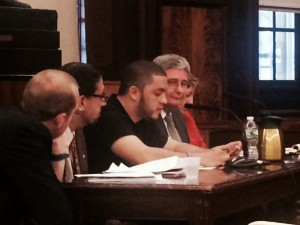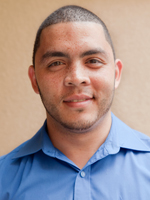Dave Casellas testifies about solitary confinement at NYC Council Hearing
Written Comments of The Bronx Defenders
New York City Council
Joint Meeting of the Committee on Fire and Criminal Justice Services and the Committee on Juvenile Justice
Good afternoon. My name is Dave Casellas, and I work as a client coordinator at The Bronx Defenders. In this role, I help Bronx Defenders clients and their families navigate and understand the Bronx Criminal Court system. I would like to thank the Council for the opportunity to testify.
I am here today because I was once held in solitary confinement. For three months, I endured the most intense physical and psychological violence that I have ever experienced. There is no question in my mind that this inhumane practice has no place on Rikers Island. I hope that my testimony will spare others from the torment that I endured. I represent the voices that are never heard – the people who, as we speak today, are looking out of the windows of their cells and into the sky.
people who, as we speak today, are looking out of the windows of their cells and into the sky.
I was only 20 years old when I went to the box. While incarcerated at a correctional facility in upstate New York, I was jumped by four inmates. After correction officers arrived at the scene, I was brought to a sergeant’s office, where I was questioned about why I had been attacked. When the officers decided that they did not like my answers to their questions, they began slapping me forcefully and repeatedly while I was seated in a chair with my hands in my pockets.
The officers then brought me to the Secure Housing Unit and made me press my head against the door to the unit so that I tumbled in face-first as soon as the door swung open. For the next three months, I spent approximately 23 hours per day confined to a small cell. My window often would not open, and the air was stifling. Almost immediately, I could feel the psychological toll of solitary confinement. My mind was filled with violent thoughts of hurting others and of hurting myself. I never received enough food, and I lost a lot of weight as a result. On many occasions, I was unable to go outside for recreation because officers would avoid taking us to the yard.
The behavior of the correction officers in the Secure Housing Unit was the worst part of being in solitary confinement. There are no cameras in the cells, and I lived in constant fear of being attacked by the people who were supposed to protect me. On two occasions, I was severely beaten by correction officers. I had bruises and marks all over my face; I have never been touched that way in my life. Everyone in my housing area was beaten by correction officers, but there is no way to report these incidents without risking retaliation. Once, an inmate told his mother about the abuse, and officers trashed his belongings while he was at a program.
Solitary confinement did not help me, and it is not helping the hundreds of people on Rikers Island who are held in extreme isolation each day. It produces only pain and abuse. As my organization, The Bronx Defenders, revealed in its report on solitary confinement, the Department of Correction’s use of this practice is rampant, particularly against young people. Out of the 59 Bronx Defenders clients interviewed for the report, twenty were teenagers and over half were between the ages of 16 and 20. Their experiences mirrored my own, and in many cases were even worse. At least 16 of the clients interviewed for the report experienced suicidal thoughts and at least five clients attempted to commit suicide. Sadly, over 70% of the clients suffered from mental illnesses that were exacerbated and under-treated during the time they spent in the box.
The extreme suffering brought on by solitary confinement cannot by justified by claims of safety and security; there are better ways to treat people and to create safe environments. The Department of Correction took small steps in the right direction by piloting its Clinical Alternative to Punitive Segregation (CAPS) program and by pledging to end the use of solitary confinement for adolescents, but it must go further. The Department of Correction must eliminate or drastically reduce the use of solitary confinement by exploring graduated punishments and the use of programs such as CAPS that create controlled settings without the use of extreme isolation. Most of all, the Department of Correction must take steps to establish accountability for correction officers, who too often brutalize and abuse individuals who are already in the custody of the state. With the Department of Justice’s investigation still ongoing, now is the time for the City Council to act on this important issue and rectify the injustices that have plagued Rikers Island for too long. It is time for an end to solitary at Rikers. Thank you.

